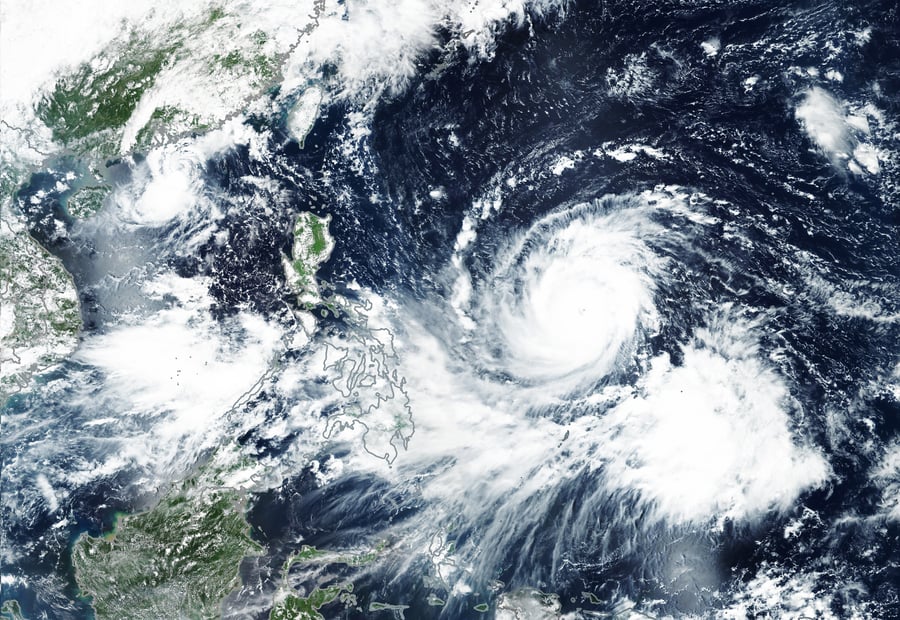
A powerful typhoon has carved a path of destruction across the Western Pacific, leaving a trail of devastation in the Philippines, battering Taiwan, and now threatening an already flood-stricken China. Typhoon Gaemi, known as Carina in the Philippines, has claimed lives, displaced hundreds of thousands, and continues to pose a significant threat as it moves towards mainland China.
In Taiwan, where Gaemi made landfall early Thursday, the storm has claimed at least two lives and injured hundreds more. The typhoon slammed into Yilan County with sustained winds up to 205 kph (125 mph), equivalent to a Category 3 major hurricane in the Atlantic. In an unexpected turn, the storm was deflected off its forecast track by Taiwan's mountainous terrain, spending more than six hours offshore making a loop near the Hualien coastline before making landfall around midnight.
The impact on Taiwan has been severe, particularly in Hualien, eastern Taiwan's most populated city. Residents endured eight hours of the typhoon's worst conditions, including winds over 100 mph (160 kph), storm surge, and torrential rainfall. Rainfall totals topped 300 mm (1 foot) in many locations, with mountainous areas receiving over 500 meters (1.5 feet).
Taiwan's Central Emergency Operations Center reported that a woman riding a motorcycle in southern Kaohsiung City was crushed to death by a fallen tree, while another woman in eastern Hualien was killed by a falling parapet. More than 200 others have been wounded.
The storm's approach prompted widespread closures across Taiwan. Financial markets, schools, and offices were shut down, and most Taiwanese cities suspended operations. Taiwan Railways halted some rapid train services, and more than 50,000 households in Kaohsiung lost power. Major airlines announced significant disruptions to their schedules, and even Taiwan's military had to adjust its plans, modifying the ongoing annual five-day Han Kuang War Games.
Before reaching Taiwan, Gaemi had already wreaked havoc in the Philippines. The death toll in the country has risen to 22, with victims claimed by flooding and landslides. Philippine President Ferdinand Marcos Jr. reported that more than 770,000 people have been affected by the typhoon and the southwest monsoon, particularly in the country's southern regions.
The situation in isolated rural villages is especially dire, with Marcos stating, "People there may not have eaten for days." In response to the crisis, 4,500 personnel have been placed on standby to assist with search and rescue operations.
In Manila, heavy rains brought by Gaemi have caused significant flooding, with streets inundated by knee-deep water. The Philippine government has closed schools and government offices in the Manila capital region and the main island of Luzon. The Philippine Stock Exchange ceased all trading on Wednesday, and numerous flights have been canceled.
Adding to the country's woes, an oil tanker sank off the coast of Bataan province during the storm. The vessel was carrying 1.4 million liters of industrial fuel oil, posing a significant environmental threat. Rough seas caused by the typhoon have hampered immediate containment efforts.
As Gaemi moves towards mainland China, authorities are on high alert. The storm is expected to make landfall in China's Fujian province on Thursday as the equivalent of a strong Category 1 or low-end Category 2 hurricane, with sustained winds of 145 to 160 kph (90 to 100 mph). Coastal areas of Fujian province are preparing for the worst, with boats mooring to take shelter and train services scheduled for suspension.
The impending arrival of Gaemi is particularly concerning for China, which has already been grappling with weeks of extreme rain and deadly flooding. In recent days, tens of thousands of people have been evacuated across multiple provinces due to floods and landslides that have blocked highways, destroyed homes, and caused devastating financial losses by wiping out crops and livestock.
By the weekend, the remnants of Gaemi are likely to spread heavy rainfall farther north into areas like Henan, Shanxi, and Hebei provinces, which have been hit hard by flooding in recent days. This latest weather crisis comes on the heels of a period of scorching temperatures in parts of central China's agricultural heartland, complicating efforts to grow and irrigate vital crops.
The rapid intensification of Typhoon Gaemi, which strengthened by 96 kph (60 mph) over a 24-hour period before hitting Taiwan, has raised concerns among scientists. This intensification, exceeding the definition of rapid intensification of 56 kph (35 mph) in 24 hours, occurred over Pacific waters that have been at their warmest temperatures on record. Researchers have found that hotter oceans caused by the human-induced climate crisis are leading storms to intensify more rapidly.
With climate change potentially intensifying such storms, the resilience of communities in typhoon-prone areas will continue to be tested in the years to come, underscoring the urgent need for enhanced disaster preparedness and climate adaptation strategies across the region.
* CNN contributed to this report.




























0 Comments